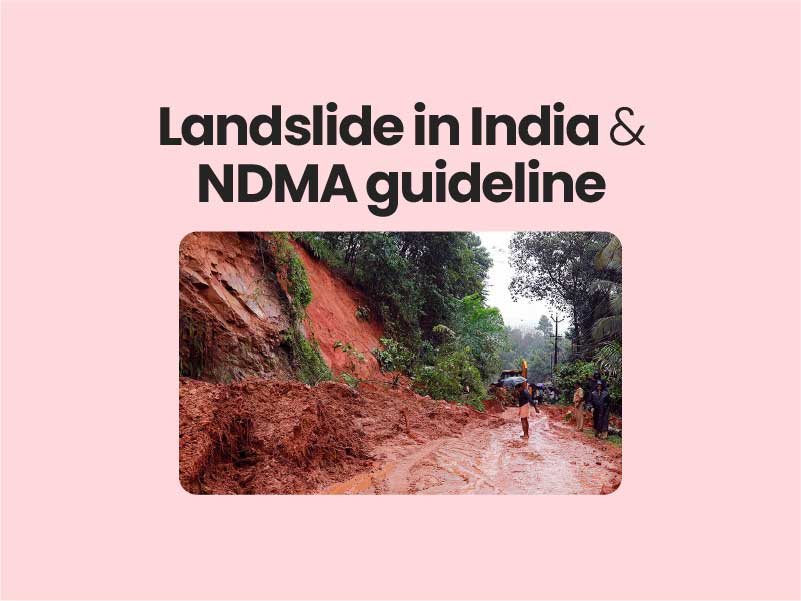Companion@360 → 7 Month programme to sharpen your writing skills → REGISTER NOW

Landslide in India and NDMA guidelines
India has the highest mountain chain on earth, the Himalayas, which are formed due to collision of Indian and Eurasian plate, the northward movement of the Indian plate towards China causes continuous stress on the rocks rendering them friable, weak and prone to landslides and earthquakes.
The slow-motion of the Indian crust, about 5 cm/year accumulates stress to which natural disasters are attributed. Some landslides make unique and unparalleled catastrophes. Landslides and avalanches are among the major hydro-geological hazards that affect large parts of India besides the Himalayas, the Northeastern hill ranges, the Western Ghats, the Nilgiris, the Eastern Ghats and the Vindhyans, in that order, covering about 15 % of the landmass The Himalayas alone count for landslides of every fame, name and description- big and small, quick and creeping, ancient and new. The Northeastern region is badly affected by landslide problems of a bewildering variety. Landslides in the Darjeeling district of West Bengal as also those in Sikkim, Mizoram, Tripura, Meghalaya, Assam, Nagaland and Arunachal Pradesh pose chronic problems, causing recurring economic losses worth billions of rupees. A different variety of landslides, characterized by a lateritic cap, pose a constant threat to the Western Ghats in the South, along the steep slopes overlooking the Konkan coast besides Nilgiris, which is highly landslide-prone.
Concerns
- Frequency of damaging landslides
- Loss assessment.
- Mitigation methods used.
- A number of buildings being built on land at risk.
- Land subject to landslide activity being set aside/purchased.
- The awareness level of the community.
Challenges
- Technical/Scientific: Integrating landslide concerns in the development of disaster management plans at different levels i.e., national, state, district, municipal/panchayat.
- Financial Issues: Criteria for disbursement of funds for servicing different areas of landslide mitigation.
- Legal Issues: I) Techno-legal regime for the introduction of sound slope protection, planned urbanization, regulated land use and environment-friendly land management practices.
- ii) Zero tolerance against deliberate environmental violence and unhealthy construction practices.
How landslide mitigation can be done?
- By restricting or even removing the population from landslides prone areas.
- By restricting certain types of land use where slopes are vulnerable.
- By installing early warning systems based on the monitoring of ground conditions such as strain in rocks and soils, slope displacement, and groundwater levels.
NDMA guidelines on Landslides and Snow Avalanches
The main objectives of the NDMA guidelines are to institutionalize the landslide hazard mitigation efforts, to make society aware of the various aspects of landslide hazard in the country and to prepare the society to take suitable action to reduce both risks and costs associated with this hazard. The recommendations include:
- Continuously updating the inventory of landslide incidences affecting the country.
- Landslide hazard zonation mapping in macro and meso scales after consultation with the Border Road Organization, State government and local communities.
- Pilot projects to be taken up in different regions of the country to carry out detailed studies and monitoring of selected landslides to assess their stability status and estimate risk.
- Setting pace setter examples for stabilisation of slides and also setting up early warning systems depending on the risk evaluation and cost-benefit ratio. v)
- Complete site-specific studies of major landslides and plan treatment measures and encourage state governments to continue these measures.
- Setting up of institutional mechanisms for generating awareness and preparedness about landslide hazard among various stakeholders.
- Enhancing landslide education, training of professionals and capacity development of organisations working in the field of landslide management.
- Capacity development and training to make the response regime more effective.
- Development of new codes and guidelines on landslide studies and revision of existing ones.
- Establishment of an autonomous national centre for landslide research, studies and management.
Vulnerability to landslides can be evaluated only if we know the exposure to landslide hazard and our preparedness to face that hazard. Vulnerability will be close to nil in the case of well managed and protected slopes.
Read Also Agricultural credit in India


